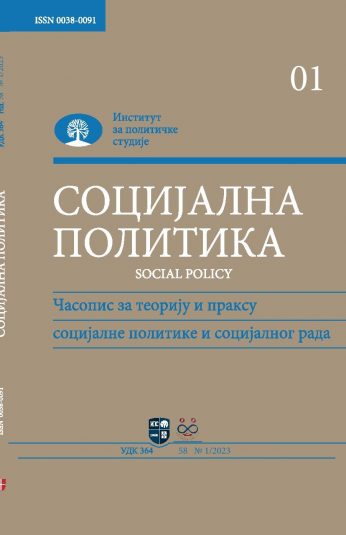Тема броја
ИЗАЗОВИ ЗАШТИТЕ ДЕЦЕ У СИСТЕМУ СОЦИЈАЛНЕ ЗАШТИТЕ
СОЦИЈАЛНО ИСКЉУЧИВАЊЕ ДРЖАВЉАНА ТРЕЋИХ ЗЕМАЉА СА ЕВРОПСКИХ ТРЖИШТА РАДА
Сажетак
Предмет анализе у овом раду је положај држављана трећих земаља на европским тржиштима рада. Циљ је утврђивање постојања и одлика неједнакости у приступу, радном ангажману и исходима на тржишту рада за држављане трећих земаља у европским државама, као и начина креирања ових неједнакости. Теоријски оквир анализе представља концепт социјалног искључивања и са њиме повезан концепт ограниченог грађанства којим се настоји образложити искључивање присилних миграната из приступа тржишту рада. Методолошки приступ се заснива на анализи садржаја легислативних, политичких и статистичких докумената. Резултати анализе указују на то да национално формулисане политике приступа тржиштима рада за мигранте имају за исход вишу стопу незапослености миграната у односу у домицилно становништво, непризнавање њихових квалификација и са тиме повезано ангажовање у нискоквалификованим и слабо плаћеним пословима за ову популацију на тржишту рада.
Референце
- Божић Саша, Кути Симона, „Еуропска политика интеграција: од стандардизирања мера за земље ЕУ према интегрцијском сервису утемељеном на друштвенознантственим појавама“, Ревија за социологију, бр.48/2018, стр. 49-75.
- Марковић Лидија, „Миграције-изазов, проблем или карактеристика нашег доба? “, Европске свеске, бр.4/2017, стр. 11-14.
- Asylum Information Database (AIDA), Country Report: Germany, Internet, https://www.asylumineurope.org/sites/default/files/report-download/aida_de_2018update.pdf, 12/10/2019.
- Asylum Information Database (AIDA), Country Report: Sweden, 2018, https://www.asylumineurope.org/reports/country/sweden, 12/10/2019.
- Asylum Information Database (AIDA), Country Report: United Kingdom, Internet, 2018https://www.asylumineurope.org/reports/country/united-kingdom, 13/10/2019.
- Asylum Information Database (AIDA), Country reports 2018, Internet, https://www.asylumineurope.org/reports, 12/10/2019.
- Eurostat, Asylum statistics, Internet, https://ec.europa.eu/eurostat/statistics-explained/index.php/Asylum_statistics, 5/10/2019.
- Blau Francine, Mackie Christopher, The Economic and Fiscal Consequences of Immigration, A Report of the National Academies, Washington DC, 2016.
- Constant Amelie, Do Migrants Take the Jobs of Native Workers?, IZA World of Labor: 10, 2014.
- Cross Malcolm, Migrants and the Generational Transition in European Cities. The Interaction of Economic, Spatial and Social Factors in the Generation of Social Exclusion, with Particular Reference to Young People, Application to the Fourth Framework Programme of the European Union (TSER), ERCOMER, Utrecht, 1998.
- Degler Eva, Liebig Thomas, Senner Anne-Sophie, Integrating Refugees into the Labour Market – Where DoesGermany Stand?, ifo DICE Report 15 (3), pp. 6-10, ifo Institute, Munich, 2017.
- Dustmann Christian, Tommaso Frattini, Preston Ian, „The Effect of Immigration along the Distribution of Wages”, Review of Economic Studies, Oxford University Press, Oxford, 80(1), pp. 145-173.
- Galera Giulia, et al., Integration of Migrants, Refugees and Asylum Seekers in Remote Areas with Declining Populations”, OECD Local Economic and Employment Development (LEED) Working Papers, 2018/03, OECD Publishing, Paris, 2018.
- Green Simon, Divergent Traditions, Converging Responses: Immigration and Integration Policy in the UK and Germany, German Politics, Volume 16, Issue 1, pp. 95-115.
- Integrationsgesetz, Bundesgesetzblatt Teil I, vol. 39, pp. 1939-1949, 2016.
- Edo Anthony, Toubal Farid, „Selective Immigration Policies and Wages Inequality”, Review of International Economics, Wiley Blackwell, 23(1), pp. 160-187.
- European Foundation for Democracy, Refugees in Europe. Review of integration practices and policies, European Foundation for Democracy, Brussels, 2018.
- European Parliamentary Research Service (EPRS), Work and social welfare for asylum-seekers and refugees, European Union, European Parliament, 2015.
- Eurostat, Migrant integration 2017 edition, Eurostat, Luxembourg, 2017.
- Migration Policy Centre, From Refugees to Workers. Mapping Labour-Market Integration Support Measures for Asylum Seekers and Refugees in EU Member States. Volume I: Comparative Analysis and Policy Findings, Gutersloh, Germany, Bertelsmann Stiftung, 2016.
- Migration Policy Centre, From Refugees to Workers. Mapping Labour-Market Integration Support Measures for Asylum Seekers and Refugees in EU Member States. Volume II: Literature Review and Country Case Studies, Gutersloh, Germany, Bertelsmann Stiftung, 2016.
- Nickell Stephen, Saleheen Jumana, The Impact of Immigration on Occupational Wages: Evidence from Britain, Bank of England, London, 2015.
- OECD, How are Refugees Faring on the Labour Market in Europe?, European Union, Luxembourg, 2016.
- OECD, OECD Factbook 2015-2016: Economic, Environmental and Social Statistics, OECD Publishing, Paris, 2016.
- OECD, Finding their Way. Labour Market Integration of Refuges in Germany, OECD Publishing, Paris, 2017.
- OECD, Indicator of immigrant integration, Internet, https://www1.compareyourcountry.org/indicators-of-immigrant-integration/en/0/all/default/all/EU, 26/10/2019.
- OECD, Making Integration Work: Refugees and Others in Need of Protection, OECD Publishing, Paris, 2016.
- Olof Aslund, Dan-Olof Rooth (2007), „Do When and Where Matter? Initial Labor Market Conditions and Immigrant Earnings”, Economic Journal, Vol. 117, No. 3, pp. 422-448.
- Schierup Carl-Ulrik, „Diversity” and Social Exclusion in Third Way Sweden, The ”Swedish Model” in Transition, 1975– 2005, REMESO, Norrköping, 2010.
- Schierup Carl‐Ulrik, Ålund Aleksandra, Likić‐Brborić Branka, „Migration, Precarization and the Democratic Deficit in Global Governance“, International Migration, John Wiley & Sons Ltd, 53(3), pp. 50–63.

